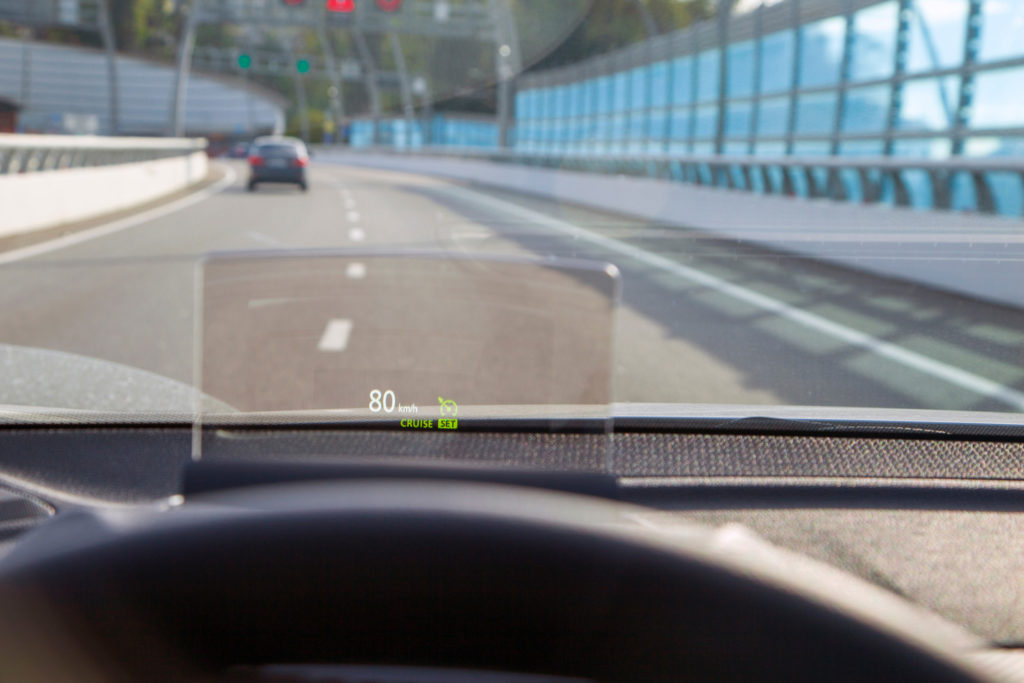“Don’t take your eyes off the road.” That’s the first thing everyone learns in driving school. Whenever you’re looking down at the dashboard to view the speedometer, you’re doing just that. Lucky for you, automakers have found an elegant solution to that problem: heads-up displays.
What are heads-up displays, and how do they help drivers navigate the road better? We’ll answer these questions in this article.
What Is a Heads-up Display?
Do you remember that scene in Iron Man where Tony Stark activates his suit and a holographic display appears before his eyes? That’s an example of an augmented-reality (AR) heads-up display or HUD. Some newer vehicles offer HUDs with AR navigation systems similar to Tony’s. In their most basic form, HUDs use images to help drivers keep track of their vehicle’s speed, determine the quickest routes, and navigate traffic with ease.
An automotive heads-up display projects information onto a vehicle’s windshield or panel. This technology was originally developed for pilots to view information without having to look down at their instrument clusters. Some luxury vehicles are equipped with HUDs that show key data, such as speed, revolution per minute (RPM), navigation, blind spot warnings, and more. Some HUDs can be reconfigured to meet the driver’s needs.

What Are the Benefits of Heads-up Displays?
HUDs function as active safety features that allow drivers to pay attention to their surroundings. According to the National Highway Traffic Safety Administration, HUDs should be used in conjunction with auditory or haptic alerts to encourage drivers to pay attention to forward hazards in critical safety situations.
The General Motors North American Operations Safety Center has published a study about the pedestrian detection benefits of HUD systems for older drivers. The research suggests that HUDs improved the ability of participants to see forward scene events. However, the study stresses that generalizations shouldn’t be drawn from this study because HUDs differ from one another.

What Are the Different Types of Heads-up Display?
Some vehicles come with built-in HUD systems. If your vehicle doesn’t have a HUD system, you can install some HUD applications or third-party options to get the same experience. Here are the three main types of HUDs.
Built-in Heads-up Displays
Some automakers offer HUDs as optional packages for their models. Built-in HUDs typically use a small projector that creates a reversed image on the windshield or panel, showing important information about a vehicle’s speed, navigation, and more. These systems are simple to use and interface seamlessly with the vehicle. However, you can’t transfer an integrated HUD to another vehicle. Vehicles with HUD options also tend to be more expensive, so keep that in mind when you’re window-shopping.
Heads-up Display Apps
With the right applications, you can turn your smartphone into an HUD. Some apps allow you to monitor your vehicle’s speed. Others use the global positioning system (GPS) to aid navigation. Although there’s a lot of free software on Google Play or the App Store, some developers charge for additional features. You also have to anchor your phone to the dashboard to keep it from sliding out.
Aftermarket Heads-up Displays
Third-party manufacturers offer aftermarket HUDs for various systems. These devices draw information from the vehicle’s onboard computer and project it onto the windshield. Aftermarket HUDs can be installed in vehicles that have 12-volt power ports or OBD-II ports. They can be easily removed and transferred to another vehicle. Make sure to do your research to find the best aftermarket heads-up display for your vehicle.

Considerations for a Heads-up Display
Here are several considerations for choosing HUDs.
Screen Size
Integrated HUDS come in different screen sizes, depending on the make and model. The average screen size is five to six inches. If you’re using your phone as a HUD, the screen size will be smaller, which can cause eye strain. When shopping for aftermarket HUDs, choose one with a large enough display so you don’t have to squint while driving.
Features
Built-in HUDs vary in design and features. Some might include features like vehicle speed, engine RPM, blind spot monitoring, navigation, battery charge signal, and infotainment systems. Aftermarket HUD systems offer some of the same features as integrated systems, but they can be just as expensive. Apps don’t offer the same range of functions.
Cost
Vehicles with built-in HUD systems usually cost more than other vehicles. However, if you’re looking for a seamless experience, you should consider integrated HUDs. Aftermarket HUD systems can cost less than integrated systems, but you also get fewer features. Some driver-assistance apps can be downloaded for free, but others require a subscription.
Which Cars Have Heads-up Displays?
Many different vehicles are offered with a HUD. For instance, the all-electric 2022 Mercedes-Benz EQS features an HUD with a futuristic AR interface that projects information on an OLED screen. Some reviewers have compared the EQS to a jet fighter because of its technologically advanced display.
The 2022 Chevrolet Silverado lets drivers customize their HUD settings with the touch of a button. The information displayed on the windshield can be repositioned, reconfigured, and readjusted for brightness.
These are just two examples of HUD systems in newer models. If you want to save money on HUD options, you should check out older models from Acura, Audi, Bentley, BMW, Buick, Chevrolet, Ford, GMC, Hyundai, and Toyota. HUDs are available as standard equipment in some of these vehicles and as optional packages in others.
Any information provided on this Website is for informational purposes only and is not intended to replace consultation with a professional mechanic. The accuracy and timeliness of the information may change from the time of publication.






























